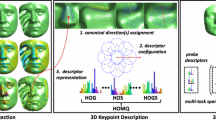Abstract
Few systems capable of recognizing complex objects with free-form (sculptured) surfaces have been developed. The apparent lack of success is mainly due to the lack of a competent modelling scheme for representing such complex objects. In this paper, a new form of point representation for describing 3D free-form surfaces is proposed. This representation, which we call the point signature, serves to describe the structural neighbourhood of a point in a more complete manner than just using the 3D coordinates of the point. Being invariant to rotation and translation, the point signature can be used directly to hypothesize the correspondence to model points with similar signatures. Recognition is achieved by matching the signatures of data points representing the sensed surface to the signatures of data points representing the model surface.
The use of point signatures is not restricted to the recognition of a single-object scene to a small library of models. Instead, it can be extended naturally to the recognition of scenes containing multiple partially-overlapping objects (which may also be juxtaposed with each other) against a large model library. No preliminary phase of segmenting the scene into the component objects is required. In searching for the appropriate candidate model, recognition need not proceed in a linear order which can become prohibitive for a large model library. For a given scene, signatures are extracted at arbitrarily spaced seed points. Each of these signatures is used to vote for models that contain points having similar signatures. Inappropriate models with low votes can be rejected while the remaining candidate models are ordered according to the votes they received. In this way, efficient verification of the hypothesized candidates can proceed by testing the most likely model first. Experiments using real data obtained from a range finder have shown fast recognition from a library of fifteen models whose complexities vary from that of simple piecewise quadric shapes to complicated face masks. Results from the recognition of both single-object and multiple-object scenes are presented.
Similar content being viewed by others
References
Besl, P. J. and Jain, R. C. 1986. Invariant surface characteristics for 3D object recognition in range images. Comput. Vision, Graphics, Image Processing, 33:33-80.
Besl, P. J. and Jain, R. C. 1988. Segmentation through variable-order surface fitting. IEEE Trans. Patt. Anal. Machine Intell., 10(2):167- 192.
Besl, P. J. and McKay, N. D. 1992. A method for registration of 3-D shapes. IEEE Trans. Patt. Anal. Machine Intell., 14(2):239- 256.
Brou, P. 1984. Using the Gaussian image to find the orientation of objects. Int'l Journal of Robotics Research, 3(4):89-125.
Chen, C. H. and Kak, A. C. 1989. A robot vision system for recognizing 3-D objects in low order polynomial time. IEEE Trans. Syst., Man Cybernetics, 19(6):1535-1563.
Chua, C. S. and Jarvis, R. A. 1993. Free-form surface registration for 3D robot vision. Proc. 6th Australian Joint Conf. Artificial Intell., Melbourne, Australia, pp. 432-437.
Chua, C. S. and Jarvis, R. A. 1994. 3D Free-form surface registration and object recognition. Int'l J. Comput. Vision (accepted for publication).
Delingette, H., Hebert, M., and Ikeuchi, K. 1993. A spherical representation for the recognition of curved objects. 4th Int'l Conf. Comput. Vision, Berlin, Germany, pp. 103-112.
Dun, J. 1990. Shape measurement using a puma 500. Technical Report GIRD 16011-7.
Fan, T. J., Medioni, G., and Nevatia, R. 1989. Recognizing 3-D objects using surface descriptions. IEEE Trans. Patt. Anal. Machine Intell., 11(11):1140-1157.
Ferrie, F. P., Mathur, S., and Soucy, G. 1993. Feature extraction for 3-D model building and object recognition. Three-Dimensional Object Recognition Systems, A. K. Jain and P. J. Flynn (Eds.), Elsevier Science Publishers, pp. 57-88.
Flynn, P. J. and Jain, A. K. 1991. BONSAI: 3-D object recognition using constrained search. IEEE Trans. Patt. Anal. Machine Intell., 13(10):1066-1075.
Flynn, P. J. and Jain, A. K. 1992. 3D object recognition using invariant feature indexing of interpretation tables. CVGIP: Image Understanding, 55(2):119-129.
Grimson, W. E. L. and Lozano-Perez, T. 1984. Model-based recognition and localization from sparse range or tactile data. Int'l Journal of Robotics Research, 3(3):3-35.
Gueziec, A. and Ayache, N. 1994. Smoothing and matching of 3D space curves. Int'l J. Comput. Vision, 12(1):79-104.
Hansen, C. and Henderson, T. 1989. CAGD-based computer vision. IEEE Trans. Patt. Anal. Machine Intell., 11(11):1181-1193.
Horn, B. K. P. 1984. Extended Gaussian images. Proc. IEEE, vol. 72, pp. 1656-1678.
Ikeuchi, K. 1981. Recognition of 3-D objects using the extended Gaussian image. Proc. 7th Int. Joint Conf. Artificial Intelligence, Vancouver, B. C., Canada, pp. 595-500.
Ikeuchi, K. and Kanade, T. 1988. Automatic generation of object recognition programs. Proc. IEEE, vol. 76, no. 8, pp. 1016-1035.
Jain, A. K. and Hoffman, R. L. 1988. Evidence-based recognition of 3D objects. IEEE Trans. Patt. Anal. Machine Intell., 10(6):783- 802.
Kalvin, A., Schonberg, E., Schwartz, J. T., and Sharir, M. 1986. 2D Model-based, boundary matching using footprints. Int'l. Journal of Robotics Research, 5(4):38-55.
Kang, S. B. and Ikeuchi, K. 1993. The complex EGI: A new representation for 3D pose determination. IEEE Trans. Patt. Anal. Machine Intell., 15(7):707-721.
Lamdan, Y. and Wolfson, H. J. 1988. Geometric hashing: A general and efficient model-based recognition scheme. 2nd Int'l Conf. Comput. Vision, pp. 238-249.
Lipschutz, M. M. 1969. Differential Geometry. McGraw-Hill: New York.
Radack, G. M. and Badler, N. I. 1989. Local matching of surfaces using a boundary-centered radial decomposition. Comput. Vision, Graphics, Image Processing, 45:380-396.
Stein, F. and Medioni, G. 1992. Structural indexing: Efficient 3-D object recognition. IEEE Trans. Patt. Anal. Machine Intell., 14(2):125-145.
Zhang, Z. 1994. Iterative point matching for registration of free-form curves and surfaces. Int'l. J. Comput. Vision, 13(2):119-152.
Author information
Authors and Affiliations
Rights and permissions
About this article
Cite this article
Chua, C.S., Jarvis, R. Point Signatures: A New Representation for 3D Object Recognition. International Journal of Computer Vision 25, 63–85 (1997). https://doi.org/10.1023/A:1007981719186
Issue Date:
DOI: https://doi.org/10.1023/A:1007981719186




